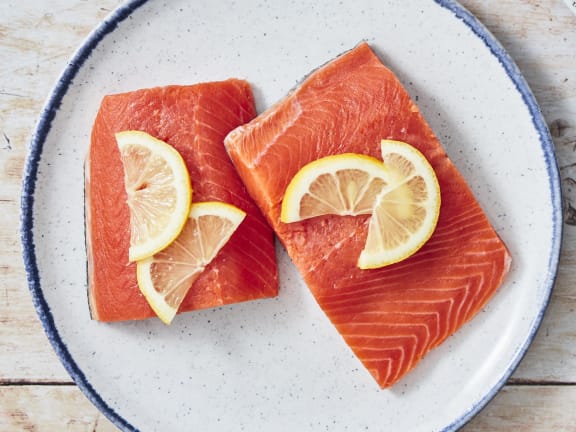Does wild-caught salmon have mercury? Yes. But does salmon have high mercury levels? No. Wild salmon has a low mercury content — especially compared to other seafood options.
In fact, most living organisms (including humans!) contain at least a little mercury in their bodies. The amount is what matters, not its existence. High levels of mercury can have a negative effect on health.
Mercury in Salmon and Other Seafood
Mercury comes in a few forms. Methylmercury, a potent toxin, is the type of mercury that concerns seafood. This pollutant is most often the result of fossil fuel burning. Toxic particles reach the sea, where the mercury enters the marine food chain. When you consume seafood contaminated with mercury, your body accumulates the compound.
In large quantities, methylmercury affects bodily functions. It can permanently disrupt developmental processes in fetuses and newborns and cause neurological issues in adults. Children are at particular risk of severe complications from mercury poisoning. Pregnant and nursing people should be cautious about the fish they consume.
How Much Mercury Is in Salmon
Experts measure fish mercury levels in parts per million (ppm). According to the FDA, fresh and frozen salmon come in at 0.022 ppm. For comparison, sardines have one of the lowest amounts of mercury at 0.013 ppm, and swordfish have one of the highest at 0.995. You can see that salmon doesn’t have much at all. The Environmental Defense Fund (EDF) also has a tool to help you figure out how much mercury is in salmon and other fish, canned and otherwise.
According to the EDF, wild Alaskan salmon contains the lowest contaminants of all the salmon varieties. It doesn't matter if it's coho, pink, or sockeye.
Why Is Salmon Low in Mercury?
Salmon is relatively low on the food chain and typically doesn’t live long enough to accumulate a lot of mercury. You’ll generally see higher levels of mercury in longer-lived species higher up in the food chain. That’s why large predators tend to contain mercury levels that are dangerous to humans when consumed in large quantities. Some examples include swordfish, ahi tuna, and large species of mackerel.
How Often Should You Consume Salmon?
You can enjoy salmon without restrictions or concerns because of its low mercury levels. This means you can include salmon in your regular diet without any worries. Experts haven’t proposed any restrictions on salmon consumption for anyone.
Integrating plenty of wild salmon into your diet — especially when pregnant, planning to be pregnant, or nursing — is an excellent idea. The omega-3 content of this fish helps to support healthy cognitive development in utero and into early childhood. The American Pregnancy Association encourages wise fish consumption throughout pregnancy due to its critical benefits to the mother. Omega-3-rich seafood is kids’ ultimate brain food and can kick-start your baby’s brain development.
What About PCBs?
You may wonder about other contaminants that may be present in Alaskan salmon.
After the Fukushima nuclear reactor accident in 2011, people worried that radioactive particles would contaminate fish from Alaskan waters. In a 2018 study, the Alaska Department of Environmental Conservation found no traces of Fukushima-related radioactive pollutants.
The contaminant to look for in salmon is PCBs, or polychlorinated biphenyls, which make their way into salmon near the shores. PCBs are industrial runoff that pollute the coastlines. Farmed salmon sometimes contains PCBs since it's often raised near pollutants. Unlike farmed salmon, wild salmon spends most of its life searching for food in the vast ocean. As a result, it's less likely to swim through high concentrations of pollutants.
So, when it comes to mercury and other pollutants, wild Alaskan salmon is the cleanest and healthiest catch.






